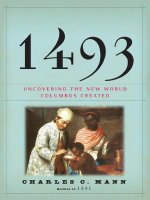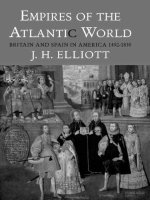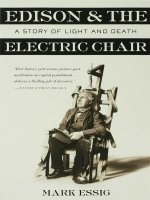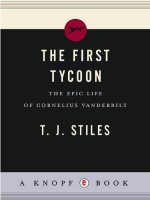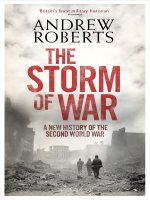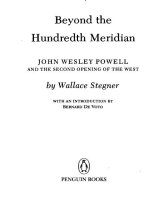Stephen nissenbaum the battle for christmas (v5 0)
Bạn đang xem bản rút gọn của tài liệu. Xem và tải ngay bản đầy đủ của tài liệu tại đây (4.61 MB, 338 trang )
Acclaim for STEPHEN NLSSENBAUM’S
The Battle for Christmas
“Erudite yet entertaining … an unusual history of consumerism … an original study.”
—Boston Globe
“A vivid, engaging achievement in social and cultural history. Nissenbaum’s interpretation of the centuries-
long struggle to control and shape our most popular holiday is a revelation. The Battle for Christmas is a rare
treat, brilliant and accessible.”
—Richard D. Brown, University of Connecticut
“Refreshingly original and utterly engaging. It is brilliant in conception and astonishing in terms of research.”
—Michael Kammen, Cornell University
“This is cultural history at its most riveting—lively, quirky, insightful. Nissenbaum has a sharp eye for the
telling detail, and a keen sense of historical development.”
—Richard Wrightman Fox, Boston University
“Using Christmas as a lens that refracts American social history as a whole, [Nissenbaum] has written a
fascinating account that demystifies Christmas and, paradoxically perhaps, humanizes it.”
—Time Out New York
“Like St. Nick himself, Stephen Nissenbaum has brought us a gift that will delight everyone fascinated with
the remarkable twists and turns of American culture.… In vivid, compelling prose, Nissenbaum shows how
the Christmas holiday has carried multiple meanings in our past.”
—Robert A. Gross, College of William and Mary
“The Battlefor Christmas renews my faith in Santa Claus, for it tells us who he really is and where he came
from…. This rewarding book shows that American Christmas was a highly contested holiday long before the
Grinch got his hands on it.”
—Peter H. Wood, Duke University
“Full of unexpected revelations about the evolution of Christmas, Nissenbaum’s book is a stellar work of
American cultural history. In probing the historical contexts of Christmas, Nissenbaum casts fresh light on
such diverse issues as consumerism, popular culture, class relations, the American family, and the AfricanAmerican experience.”
—David Reynolds, Baruch College
“Nissenbaum’s excursion is both enlightening and entertaining in this well-researched book. He travels the
centuries with a focus, weaving between the class struggles that define almost every age.”
—New Jersey Star Ledger
STEPHEN NISSENBAUM
The Battle for Christmas
Stephen Nissenbaum received his A.B. from Harvard College in 1961, his M.A. from
Columbia University in 1963, and his Ph.D. from the University of Wisconsin in 1968.
He has taught at the University of Massachusetts, Amherst, since 1968, and is currently
professor of history there. He has been the recipient of fellowships from the National
Endowment for the Humanities, the American Council of Learned Societies, the
American Antiquarian Society, the Massachusetts Historical Society, and the Charles
Warren Center at Harvard. In addition, he was James P. Harrison Professor of History
at the College of William and Mary, 1989–90. Active in the public humanities, he has
served as member and president of the Massachusetts Foundation for the Humanities,
and as historical advisor for several lm productions. The Battle for Christmas was a
Pulitzer Prize finalist in History in 1997.
ALSO BY STEPHEN NISSENBAUM
Salem Possessed:
The Social Origins of Witchcraft
(with Paul Boyer, 1974)
Sex, Diet, and Debility in Jacksonian America
Sylvester Graham and Health Reform (1980)
The Pursuit of Liberty:
A History of the American People
(with others, 1984, 1990, 1996)
EDITOR
The Great Awakening at Yale College (1972)
Salem-Village Witchcraft:
A Documentary Record of Local Conflict
in Colonial New England
(with Paul Boyer, 1972, 1993)
The Salem Witchcraft Papers:
Verbatim Transcripts of the Legal Documents
of the Salem Witchcraft Outbreak of 1692
(with Paul Boyer, 1977)
Nathaniel Hawthorne,
The Scarlet Letter and Selected Writings (1984)
For
William R. Taylor
My teacher
Contents
Preface
1. New England’s War on Christmas
2. Revisiting “? Visit from St. Nicholas”
3. The Parlor and the Street
4. Affection’s Gift: Toward a History of Christmas Presents
5. Under the Christmas Tree: A Battle of Generations
6. Tiny Tim and Other Charity Cases
7. Wassailing Across the Color Line: Christmas in the Antebellum South
Epilogue: The Ghosts of Christmas Past
Notes
Acknowledgments
Preface
THIS BOOK had its beginnings more than twenty years ago, when I delivered a speculative
scholarly paper titled “From ‘The Day of Doom’ to ‘The Night Before Christmas.’” In that
paper I dealt with the striking parallels between the best-known American poem of the
1600s and 1700s and the best-known American poem of the 1800s and 1900s. The
earlier poem was about God’s wrath, the later one about the goodwill of Santa Claus—
but somehow the two were engaging in a kind of dialogue with each other.
Actually, though, it is clear that the book began earlier still, with my childhood
fascination for “The Night Before Christmas,” whose verses I recited over and over when
December came around. For me, growing up as I did in an Orthodox Jewish household,
this was surely part of my fascination for Christmas itself, that magical season which
was always beckoning, at school and in the streets, only to be withheld each year by the
forces of religion and family. (I once decided that Christmas must mean even more to
America’s Jewish children than to its Christian ones.) I can remember, one Christmas
Day, putting some of my own toys in a sack and attempting to distribute them to other
children who lived in my Jersey City apartment house: If I couldn’t get presents, at least
no one stopped me from giving them away, and in that fashion at least I could
participate in the joy of what, much later, I would come to think of as the “gift
exchange.”
Much later came soon enough. By the late 1980s I had been a professional historian
for some twenty years, and I was also regularly engaging in the nonacademic aspects of
my trade. In 1988 I found myself involved in the development of a teacher-training
program sponsored by Old Sturbridge Village, the living-history museum in central
Massachusetts. The theme we decided to focus on with the teachers (they taught grades
3–8) was holidays. Remembering that paper I had written more than a decade earlier, I
gured young children might be intrigued by seeing unfamiliar things in “A Visit from
St. Nicholas,” that most familiar of poems. (“Mama in her ’kerchief and I in my cap …”?
“Away to the window … and threw up the sash …”? “A miniature sleigh”? “Eight tiny
reindeer”?) So I volunteered to take on Christmas myself.
Preparing for my session, I made a series of startling discoveries that precipitated me
into writing this book. To begin with, in an essay by the preeminent modern scholar of
St. Nicholas, Charles W. Jones, I learned that “Santa Claus,” far from being a creature of
ancient Dutch folklore who made his way to the New World in the company of
immigrants from Holland, was essentially devised by a group of non-Dutch New Yorkers
in the early nineteenth century. (This discovery tied into another new notion I was
acquainted with in a di erent context, that of “invented traditions”—customs that are
made up with the precise purpose of appearing old-fashioned: the idea, for example,
that every Scottish clan had its own unique tartan plaid—which turns out to have been
the product of a nineteenth-century effort to romanticize the valiant Scots.)
Second, from reading a biographical sketch of Clement Clarke Moore, the author of “A
Visit from St. Nicholas,” I realized that the history of his best-loved poem was
intertwined with the physical and political transformation of New York City during the
early nineteenth century. Moore, it turned out, was a wealthy and politically
conservative country gentleman who found himself at war with the encroaching forces
of New York’s commercial and residential development at the very time he was writing
his undying verses about the night before Christmas.
It was my third discovery that helped make sense of that curious convergence. The
Christmas season itself was undergoing a change, I learned. From the writings of several
obscure nineteenth-century folklorists, along with contemporary historians Peter Burke
and Natalie Zemon Davis and Russian theorist Mikhail Bakhtin, I discovered that
Christmas had once occasioned a kind of behavior that would be shocking today: It was
a time of heavy drinking when the rules that governed people’s public behavior were
momentarily abandoned in favor of an unrestrained “carnival,” a kind of December
Mardi Gras. And I found that in the early nineteenth century, with the growth of
America’s cities, that kind of behavior had become even more threatening, combining
carnival rowdiness with urban gang violence and Christmas-season riots. (My key
guides here were essays by the great British historian E. P. Thompson and one of his
American disciples, Susan G. Davis.) Given the changed historical circumstances of the
nineteenth century, I began to understand the appeal of a new-styled Christmas that
took place indoors, within the secure confines of the family circle.
Those discoveries became the basis of much of the rst three chapters of this book.
Before long, I found myself exploring other issues, issues that stemmed from what I was
learning about the creation of a new-styled domestic Christmas: At what point, and in
what fashion, did Christmas become commercialized? What happened to family
relationships on this holiday, when children became the center of attention and the
recipients of lavish gifts? (After all, before our own day, weren’t parents supposed to
have avoided at all costs such gestures of intergenerational indulgence?) So I began to
think about Christmas in the context of the larger history of consumer culture and childrearing practices. Once again, I came up with some rather unexpected ndings, ndings
that drove me to the conclusion that where Christmas was concerned, the problems of
our own age go back a long way. The Christmas tree itself, I discovered, rst entered
American culture as a ritual strategy designed to cope with what was already being
seen, even before the middle of the nineteenth century, as a holiday laden with crass
materialism—a holiday that had produced a rising generation of greedy, spoiled
children.
Those issues became the subjects of Chapters 4 and 5. The remaining two chapters,
about Christmas charity and Christmas under slavery, respectively, resulted from two
very di erent circumstances. I had intended, from an early point, to write about
Dickens’s novella A Christmas Carol, that other classic text of the holiday season (along
with Moore’s poem). But when I reread Dickens’s book (for the rst time in many
years), I was led to explore the intricate and not always proud history of face-to-face
Christmas charity, especially as it related to impoverished children. As far as Christmas
under slavery is concerned, it was my students at the College of William and Mary,
where I taught during the 1989–90 academic year, who provoked my interest in that
subject. The documentary materials several of these students brought to me proved to be
something of a revelation. I glimpsed a picture of Christmas under slavery that oddly
resembled the pre-nineteenth-century carnival celebration I had discovered at the
beginning of my work. As I struggled to achieve a deeper understanding of the slaves’
holiday, I realized that with this topic my project had come full circle and it was time to
stop.
One consequence of stopping there was that my book would essentially come to a halt
with the turn of the twentieth century, well before the present day. But, I decided, this
was exactly where I wished to stop. By the end of the nineteenth century, if not earlier,
the Christmas celebration practiced by most Americans was one that would be quite
familiar to their modern descendants. Between then and now, the modi cations have
been more of degree than of kind, more quantitative than qualitative. The important
changes—the revealing changes—had all taken place. And those were the only changes I
really cared about.
For the real subject of this book is not so much Christmas itself as what Christmas can
tell us about broader historical questions. In writing about the commercialization of
Christmas, for example, or the way Christmas made children the center of attention and
a ection, I have always tried to remember that those changes were expressions of the
same forces that were transforming American culture as a whole. But it has been equally
important for me also to see Christmas as one of those very forces—as a cause as well as
an e ect, an active instrument of change as well as an indicator and a mirror of change.
From that angle, Christmas itself played a role in bringing about both the consumer
revolution and the “domestic revolution” that created the modern family.
To raise such questions in this context is new. Until recently, the history of holidays
has pretty much been written in what could be called an “antiquarian” fashion, as a
subject that existed in isolation, sealed o from matters of broad importance. It is
largely the work of anthropologists that has provoked a new look, by showing that the
holiday season has long been serious cultural business. Christmas rituals—whether in the
form of the rowdy excesses of carnival or the more tender excesses that surround the
Christmas tree—have long served to trans gure our ordinary behavior in an almost
magical fashion, in ways that reveal something of what we would like to be, what we
once were, or what we are becoming despite ourselves. It is because the celebration of
Christmas always illuminates these underlying features of the social landscape—and
sometimes the very “fault lines” which threaten to divide it—that the content of the
holiday, its timing, and even the matter of whether to celebrate it at all, have often
been hotly contested. For this reason the book I have written constitutes just a single
large chapter in the history of the perennial battle for Christmas.
But if I am concerned with those larger issues, I remain fascinated by Christmas itself,
as fascinated today as when I was a child in that Jersey City apartment house—perhaps
even more so, in the light of what I have learned in writing this book. For if I am
writing about Christmas with the larger goals of a social and cultural historian, I also
aim to tell a good story in a new way. Whether I have succeeded or not, I know that I
have at least (and at last) managed to make Christmas my own, and I hope I have done
so without betraying either its enduring meanings or my own patrimony.
Cambridge, Massachusetts
June 1995
CHAPTER 1
New England’s War on Christmas
I
THE PURITAN WAR ON MISRULE
ENGLAND, for the rst two centuries of white settlement most people did not
celebrate Christmas. In fact, the holiday was systematically suppressed by Puritans
during the colonial period and largely ignored by their descendants. It was actually
illegal to celebrate Christmas in Massachusetts between 1659 and 1681 (the ne was ve
shillings). Only in the middle of the nineteenth century did Christmas gain legal
recognition as an o cial public holiday in New England. Writing near the end of that
century, one New Englander, born in 1822, recalled going to school as a boy on
Christmas Day, adding that even as late as 1850, in Worcester, Massachusetts, “The
courts were in session on that day, the markets were open, and I doubt if there had ever
been a religious service on Christmas Day, unless it were Sunday, in that town.” As late
as 1952, one writer recalled being told by his grandparents that New England mill
workers risked losing their jobs if they arrived late at work on December 25, and that
sometimes “factory owners would change the starting hours on Christmas Day to ve
o’clock or some equally early hour in order that workers who wanted to attend a church
service would have to forego, or be dismissed for being late for work.”1
As we shall see, much of this is misleading or exaggerated. It is true that the New
England states did not grant legal recognition to Christmas until the middle of the
nineteenth century, but neither did most of the other states. There were Christmas Day
religious services in Worcester before 1850. And nineteenth-century factory owners had
their own reasons for treating Christmas as a regular working day, reasons that had
more to do with industrial capitalism than with Puritan theology. Still, the fact remains
that those factory owners were indeed operating within a long New England tradition of
opposition to Christmas. As early as 1621, just one year after the Pilgrims landed on
Plymouth Rock, their governor, William Bradford, found some of the colony’s new
residents trying to take the day o . Bradford ordered them right back to work. And in
1659 the Massachusetts General Court did in fact declare the celebration of Christmas to
be a criminal offense.
Why? What accounts for this strange hostility? The Puritans themselves had a plain
reason for what they tried to do, and it happens to be a perfectly good one: There is no
biblical or historical reason to place the birth of Jesus on December 25. True, the Gospel
of Luke tells the familiar story of the birth of Jesus of Nazareth—how the shepherds
were living with their ocks in the elds of Judea, and how, one night, an angel
appeared to them and said, “For unto you is born this day in the city of David a Savior,
N NEW
which is Christ the Lord.” But nowhere in this account is there any indication of the
exact date, or even the general season, on which “this day” fell. Puritans were fond of
saying that if God had intended for the anniversary of the Nativity to be observed, He
would surely have given some indication as to when that anniversary occurred. (They
also argued that the weather in Judea during late December was simply too cold for
shepherds to be living outdoors with their flocks.)
It was only in the fourth century that the Church o cially decided to observe
Christmas on December 25. And this date was chosen not for religious reasons but
simply because it happened to mark the approximate arrival of the winter solstice, an
event that was celebrated long before the advent of Christianity. The Puritans were
correct when they pointed out—and they pointed it out often—that Christmas was
nothing but a pagan festival covered with a Christian veneer. The Reverend Increase
Mather of Boston, for example, accurately observed in 1687 that the early Christians
who rst observed the Nativity on December 25 did not do so “thinking that Christ was
born in that Month, but because the Heathens Saturnalia was at that time kept in Rome,
and they were willing to have those Pagan Holidays metamorphosed into Christian
[ones].”2
Most cultures (outside the tropics) have long marked with rituals involving light and
greenery those dark weeks of December when the daylight wanes, all culminating in the
winter solstice—the return of sun and light and life itself. Thus Chanukah, the “feast of
lights.” And thus the Yule log, the candles, the holly, the mistletoe, even the Christmas
tree—pagan traditions all, with no direct connection to the birth of Jesus.3
But the Puritans had another reason for suppressing Christmas. The holiday they
suppressed was not what we probably mean when we think of a traditional Christmas.
As we shall see, it involved behavior that most of us would nd o ensive and even
shocking today—rowdy public displays of excessive eating and drinking, the mockery of
established authority, aggressive begging (often involving the threat of doing harm),
and even the invasion of wealthy homes.
It may seem odd that Christmas was ever celebrated in such a fashion. But there was a
good reason. In northern agricultural societies, December was the major “punctuation
mark” in the rhythmic cycle of work, a time when there was a minimum of work to be
performed. The deep freeze of midwinter had not yet set in; the work of gathering the
harvest and preparing it for winter was done; and there was plenty of newly fermented
beer or wine as well as meat from freshly slaughtered animals—meat that had to be
consumed before it spoiled. St. Nicholas, for example, is associated with the Christmas
season chie y because his “name-day,” December 6, coincided in many European
countries with the end of the harvest and slaughter season.4
In our own day the Christmas season begins as early as the day after Thanksgiving for
many people, and continues to January 1. But our culture is by no means the rst in
which “Christmas” has meant an entire season rather than a single day. In early modern
Europe, the Christmas season might begin as early as late November and continue well
past New Year’s Day. (We still sing about “the twelve days of Christmas,” and the British
still celebrate “Twelfth Night.”) In England the season might open as early as midDecember and last until the rst Monday after January 6 (dubbed “Plow Monday,” the
return to work), or later.5 But it isn’t very useful, nally, to try to pin down the exact
boundaries of a “real” Christmas in times past, or the precise rituals of some
“traditional” holiday season. Those boundaries and rituals changed over time and varied
from one place to another. What is more useful, in any setting, is to look for the
dynamics of an ongoing contest, a push and a pull—sometimes a real battle—between
those who wished to expand the season and those who wished to contract and restrict it.
(Nowadays the contest may pit merchants—with children as their allies—against those
grown-ups who resent seeing Christmas displays that seem to go up earlier and earlier
with each passing year.)
In early modern Europe, roughly the years between 1500 and 1800, the Christmas
season was a time to let off steam—and to gorge. It is difficult today to understand what
this seasonal feasting was like. For most of the readers of this book, good food is
available in su cient quantity year-round. But early modern Europe was above all a
world of scarcity. Few people ate much good food at all, and for everyone the
availability of fresh food was seasonally determined. Late summer and early fall would
have been the time of fresh vegetables, but December was the season—the only season
—for fresh meat. Animals could not be slaughtered until the weather was cold enough to
ensure that the meat would not go bad; and any meat saved for the rest of the year
would have to be preserved (and rendered less palatable) by salting. December was also
the month when the year’s supply of beer or wine was ready to drink. And for farmers,
too, this period marked the start of a season of leisure. Little wonder, then, that this was
a time of celebratory excess.
Excess took many forms. Reveling could easily become rowdiness; lubricated by
alcohol, making merry could edge into making trouble. Christmas was a season of
“misrule,” a time when ordinary behavioral restraints could be violated with impunity.
It was part of what one historian has called “the world of carnival.” (The term carnival is
rooted in the Latin words carne and vale—“farewell to esh.” And “ esh” refers here not
only to meat but also to sex—carnal as well as carnivorous.) Christmas “misrule” meant
that not only hunger but also anger and lust could be expressed in public. (It was no
accident, wrote Increase Mather, that “December was called Mensis Genialis, the
Voluptuous Month.”6) Often people blackened their faces or disguised themselves as
animals or cross-dressed, thus operating under a protective cloak of anonymity. The
late-nineteenth-century historian John Ashton reports one episode from Lincolnshire in
1637, in which the man selected by a crowd of revelers as “Lord of Misrule” was publicly
given a “wife,” in a ceremony led by a man dressed as a minister (he read the entire
marriage service from the Book of Common Prayer). Thereupon, as Ashton noted in
Victorian language, “the affair was carried to its utmost extent.”7
Episodes like these o ered another reason, and a deeper one, for the Puritans’
objection to Christmas. Here is how the Reverend Increase Mather of Boston put it in
1687:
The generality of Christmas-keepers observe that festival after such a manner as is highly dishonourable to
the name of Christ. How few are there comparatively that spend those holidays (as they are called) after an
holy manner. But they are consumed in Compotations, in Interludes, in playing at Cards, in Revellings, in
excess of Wine, in mad Mirth….
And Increase Mather’s son Cotton put it this way in 1712: “[T]he Feast of Christ’s
Nativity is spent in Reveling, Dicing, Carding, Masking, and in all Licentious Liberty …
by Mad Mirth, by long Eating, by hard Drinking, by lewd Gaming, by rude Reveling
…”8
Even an Anglican minister, a man who approved of “keeping” Christmas (as it was
then put), acknowledged the truth of the Puritans’ charges. Writing in 1725, the
Reverend Henry Bourne of Newcastle, England, called the way most people commonly
behaved during the Christmas season “a Scandal to Religion, and an encouraging of
Wickedness.” Bourne admitted that for Englishmen of the lower orders the Christmas
season was merely “a pretense for Drunkenness, and Rioting, and Wantonness.” And he
believed the season went on far too long. Most Englishmen, Bourne claimed, chose to
celebrate it well past the o cial period of twelve days, right up to Candlemas Day on
February 2. For that entire forty-day period, it was common “for Men to rise early in the
Morning, that they may follow strong Drink, and continue untill Night, till Wine inflame
them.”
Bourne singled out two particularly dangerous seasonal practices, mumming and
(strange to modern readers) the singing of Christmas carols. Mumming usually involved
“a changing of Clothes between Men and Women; who when dressed in each other’s
habits, go from one Neighbor’s house to another … and make merry with them in
disguise.” Bourne proposed that “this Custom, which is still so Common among us at this
Season of the Year, [be] laid aside; as it is the Occasion of much Uncleanness and
Debauchery.” As for singing Christmas carols, that practice was a “disgrace,” since it
was “generally done, in the midst of Rioting and Chambering, and Wantonness.”9
(“Chambering” was a common euphemism for fornication.) It was another Anglican
cleric, the sixteenth-century bishop Hugh Latimer, who put the matter most succinctly:
“Men dishonour Christ more in the twelve days of Christmas, than in all the twelve
months besides.”
The Puritans knew what subsequent generations would forget: that when the Church,
more than a millennium earlier, had placed Christmas Day in late December, the
decision was part of what amounted to a compromise, and a compromise for which the
Church paid a high price. Late-December festivities were deeply rooted in popular
culture, both in observance of the winter solstice and in celebration of the one brief
period of leisure and plenty in the agricultural year. In return for ensuring massive
observance of the anniversary of the Saviors birth by assigning it to this resonant date,
the Church for its part tacitly agreed to allow the holiday to be celebrated more or less
the way it had always been. From the beginning, the Church’s hold over Christmas was
(and remains still) rather tenuous. There were always people for whom Christmas was a
time of pious devotion rather than carnival, but such people were always in the
minority. It may not be going too far to say that Christmas has always been an
extremely di cult holiday to Christianize. Little wonder that the Puritans were willing to
save themselves the trouble.
THE PURITANS understood another thing, too: Much of the seasonal excess that took place at
Christmas was not merely chaotic “disorder” but behavior that took a profoundly
ritualized form. Most fundamentally, Christmas was an occasion when the social
hierarchy itself was symbolically turned upside down, in a gesture that inverted
designated roles of gender, age, and class. During the Christmas season those near the
bottom of the social order acted high and mighty. Men might dress like women, and
women might dress (and act) like men. Young people might imitate and mock their
elders (for example, a boy might be chosen “bishop” and take on for a brief time some
of the authority of a real bishop). A peasant or an apprentice might become “Lord of
Misrule” and mimic the authority of a real “gentleman.”10 Increase Mather explained
with an anthropologist’s clarity what he believed to be the origins of the practice: “In
the Saturnalian Days, Masters did wait upon their Servants…. The Gentiles called
Saturns time the Golden Age, because in it there was no servitude, in Commemoration
whereof on his Festival, Servants must be Masters.” This practice, like so many others,
was simply picked up and transposed to Christmas, where those who were low in station
became “Masters of Misrule.”11 To this day, in the British army, on December 25 o cers
are obliged to wait upon enlisted men at meals.*
The most common ritual of social inversion during the Christmas season involved
something that is associated with Christmas in our own day—we would call it charity.
Prosperous and powerful people were expected to o er the fruits of their harvest bounty
to their poorer neighbors and dependents. A Frenchman traveling in late-seventeenthcentury England noted that “they are not so much presents from friend to friend, or
from equal to equal …, as from superior to inferior.”12 That may sound familiar enough.
But the modern notion of charity does not really convey a picture of how this
transaction worked. For it was usually the poor themselves who initiated the exchange,
and it was enacted face-to-face, in rituals that would strike many of us today as an
intolerable invasion of privacy.
At other times of the year it was the poor who owed goods, labor, and deference to
the rich. But on this occasion the tables were turned—literally. The poor—most often
bands of boys and young men—claimed the right to march to the houses of the well-todo, enter their halls, and receive gifts of food, drink, and sometimes money as well. And
the rich had to let them in—essentially, to hold “open house.” Christmas was a time
when peasants, servants, and apprentices exercised the right to demand that their
wealthier neighbors and patrons treat them as if they were wealthy and powerful. The
Lord of the Manor let the peasants in and feasted them. In return, the peasants o ered
something of true value in a paternalistic society—their goodwill. Just when and how
this actually happened each year—whether it was a gracious o ering or the forced
concession to a hostile confrontation—probably depended on the particular individuals
involved as well as the local customs that had been established in years past (and which
were constantly being “re-negotiated” through just such ritualized practices as these).
This exchange of gifts for goodwill often included the performance of songs, often
drinking songs, that articulated the structure of the exchange. These songs (and the
ritual as a whole) bore a variety of names. One name that is still known in our culture is
that of wassailing, and I shall take the liberty of using this word to refer to a whole set of
similar rituals that may have had other names. Wassailers—roving bands of youthful
males—toasted the patron’s well-being while drinking the beer he had been kind enough
to supply them. Robert Herrick included this wassail in his 1648 poem “Ceremonies for
Christmasse”:
Come bring, with a noise,
My merrie, merrie boys,
The Christmas log to the firing;
While my good dame she
Bids ye all be free [i.e., with the alcohol]
And drink to your heart’s desiring….13
The wassail usually possessed an aggressive edge—often an explicit threat—
concerning the unpleasant consequences to follow if the beggars’ demands were not
met. One surviving wassail song contains this blunt demand and threat:
We’ve come here to claim our right….
And if you don’t open up your door,
We will lay you flat upon the floor.
But there was also the promise of goodwill if the wassailers were treated well—toasts
to the patrons health and prosperity. (It is the promise of goodwill, alone from this
ritualized exchange, that has been retained in the modern revival of old Christmas
songs.) The following wassail was sung on the Isle of Man by bands of young men who
marched from house to house begging for food:
Again we assemble, a merry New Year
To wish to each one of the family here….
May they of potatoes and herrings have plenty,
With butter and cheese, and each other dainty….
One song that has recently been revived, the “Gloucestershire Wassail,” shows the
drinkers going from one well-to-do house to another (“Wassail! Wassail! all over the
town”). At each stop they wish their patron a successful harvest, the fruits of which are
to be shared with them (“God send our master a cup of good beer…. God send our
mistress a good Christmas pie …”). Each verse amounts to a toast that ends in a fresh
round of drinks (“With my wassailing bowl I drink to thee”)—to the master and
mistress, to their horse, to their cow, to anything at all that can be toasted.14
It was not enough for the landlord to let the peasants in and feed them. On this one
occasion he had to share with them his choicest food and drink, his private stock. Robert
Herrick included a couplet to this e ect in the poem quoted above: “Drink now the
strong beere, / Cut the white loaf here.” (The emphasis is on the “strong beere,” the
“white loaf.”) When the wassailers on the Isle of Man had sung their verses, they were,
in the words of the folklorist who recorded their ritual, “invited into the house to
partake of the best the family can a ord.” The nal verse of the “Gloucestershire Wassail”
opens with just such a demand for choice beer (“Come, butler, draw us a bowl of the
best / Then we hope your soul in heaven shall rest”), but the threat follows quickly: “But
if you draw us a bowl of the small [i.e., weak beer], / Then down will come butler,
bowl, and all.”15
In an agricultural economy, the kind of “misrule” I have been describing did not really
challenge the authority of the gentry. The historian E. P. Thompson has noted that
landed gentlemen could always try to use a generous handout at Christmas as a way of
making up for a year’s accumulation of small injustices, regaining in the process their
tenants’ goodwill. In fact, episodes of misrule were widely tolerated by the elite. Some
historians argue that role inversions actually functioned as a kind of safety valve that
contained class resentments within clearly de ned limits, and that by inverting the
established hierarchy (rather than simply ignoring it), those role inversions actually
served as a rea rmation of the existing social order. 16 It was all a little like Halloween
todays—when, for a single evening, children assume the right to enter the houses of
neighbors and even strangers, to demand of their elders a gift (or “treat”) and to
threaten them, should they fail to provide one, with a punishment (or “trick”).
This kind of trick-or-treat ritual is largely nonexistent today at Christmas, but vestiges
of it do remain. Take, for instance, a December 1991 article in Money magazine, which
warns its readers to “Tip Defensively” at Christmas: “‘At holiday time you must show
people who work for you that you appreciate good service,’…. Translation: if you don’t,
you’ll su er the consequences all next year (Day-Glo hair tinting or sprinkler-soaked
newspapers)…. Keep in mind a kind of reverse Marxism: to each according to your
need. That is, tip most generously those who can do you the most damage.”17
PROSECUTING THE CHRISTMAS-KEEPERS, 1620–1750
In early modern Europe, all this postharvest behavior operated within (though at the
boundaries of) the normal social order. It was part of a cultural world that went back
thousands of years and involved the yearly agricultural cycle, which de ned and
integrated work and play, with times of intense labor followed by periods of equally
intense celebration. This seasonal cycle, perhaps more than anything else, was what
determined the texture of people’s lives. It was even appropriated by the Church (as the
Christmas season itself had been) and given a religious gloss, whereby times of
celebration were associated with any number of o cial saints’ days that were generally
observed with more revelry than piety.
Here was exactly what the Puritans tried to suppress when they came to power in
England, and New England, in the middle of the seventeenth century. It was this entire
cultural world, with its periodic seasons of labor and festivity—and not just Christmas
itself—that Puritans felt to be corrupt, “pagan,” evil. It was this world that they
systematically attempted to abolish and “purify.” They wished to replace it with a
simpler, more orderly culture in which people were more disciplined and self-regulated,
in which ornate churches and cathedrals were replaced by plain “meetinghouses,” in
which lavish periodic celebrations—the seasonal cycle itself—were replaced by an
orderly and regular succession of days, punctuated only by a weekly day of rest and
self-examination, the Sabbath.
Christmas was an important (and symbolically charged) expression of this cultural
world, and the Puritans attacked it with particular intensity. In England, the Puritan
Parliament made a point of holding regular sessions each December 25 from 1644
through 1656, and it did what it could to suppress the traditional observance of the date.
(In 1644 Parliament actually decreed that December 25 was to be observed as a day of
fasting and repentance—for the sinful way the occasion had been made into a time of
“giving liberty to carnall and sensual delights.”)18 One unhappy Englishman referred to
those delights as nothing more than “liberty and harmless sports … [by] which the
toiling plowswain and labourer were wont to be recreated, and their spirits and hopes
revived for a whole twelve month.” But the Puritans had made these innocent customs
“extinct and put out of use … as if they never had been…. Thus are the merry lords of
misrule suppressed by the mad lords of bad rule at Westminster [i.e., Parliament].”19
“The Tryal of Father Christmas.” The title page of a 1686 British book mocking the
Puritans who had suppressed Christmas—and who had been out of power in England for
some twenty-five years when this book was published. The Puritan jurors in this trial
bore such names as “Mr. Cold-kitchen,” “Mr. Give-little,” and “Mr. Hate-good.”
(Courtesy, Mark Bond-Webster)
In England the success of the Puritans was limited and temporary. Legislation
banning the celebration of Christmas was contested in many places even during the
1640s and 1650s, when Puritans controlled the government (there were riots in several
towns), and the policy was quickly reversed in 1660 upon the restoration of the English
monarchy.20
But in New England the Puritans did largely succeed in eliminating Christmas, along
with many of the other practices of English popular culture. David D. Hall has succinctly
described the “transformed culture” of what he aptly terms a “new Protestant
vernacular”:
Psalm-singing replaced ballads. Ritual was reorganized around the celebration of the Sabbath and of fast days.
No town in New England had a Maypole; no group celebrated Christmas or St. Valentine’s Day, or staged a
pre-Lenten carnival!21
TAKE THE EXAMPLE of almanacs. Almanacs had become popular in England by the
seventeenth century, and they remained popular in New England as well. English
almanacs generally listed Christmas, along with the bevy of saints’ days that showed the
commitment of the Church of England to the old, seasonally based calendar. (These
saints’ days were known as “red-letter days,” because in English almanacs and church
calendars they were printed in red ink.) But in seventeenth-century New England,
almanacs were “puri ed” of all these old associations. (Indeed, for a time even the
common names for the days of the week were purged from the almanacs on account of
their pagan origins—after all, Thursday meant “Thor’s day,” and Saturday was “Saturn’s
day.”) The Puritans knew that the power to name time was also the power to control it.
So it should come as no surprise that seventeenth-century Massachusetts almanacs did
not refer to December 25 as Christmas Day. Instead, the date December 25 would be left
without comment, or it would contain a notice that one of the county courts was due to
sit that day—an implicit reminder that in New England, December 25 was just another
workday.
?HE SUCCESS of the New England Puritans was impressive and long-lasting. Christmas was
kept on the margins of early New England society. Still, it was never suppressed
completely. Take, for example, two instances that are sometimes cited to show that the
Puritan authorities succeeded in abolishing Christmas. We have already encountered the
rst of these in the entry for Christmas Day, 1621, in the journal of Governor William
Bradford of Plymouth Colony. Bradford encountered a group of people who were taking
the day o from work, and he promptly sent them back to work. Here, in the rst full
year of the Pilgrims’ life in the New World, were a group of Christmas-keepers. Nor did
this group observe Christmas in a devout fashion or even by simply staying in their
houses—Bradford indicated that he would have allowed them that. What bothered the
governor was that these Christmas-keepers were, in his own words, out “gaming [and]
reveling in the streets.”22
The second instance is the 1659 law passed by the Massachusetts Bay Colony, the law
that levied a ve-shilling ne on anyone who was “found observing any such day as
Christmas or the like, either by forbearing of labor, feasting, or any other way.”
Such laws are not made, of course, unless there are people who are engaging in the
forbidden activity. And the Massachusetts Bay law of 1659, like Governor Bradford’s
earlier report, suggests that there were indeed people in Massachusetts who were
observing Christmas in the late 1650s. The law was clear on this point: It was designed
“for preventing disorders arising in several places within this jurisdiction, by reason of
some still observing such Festivals as were superstitiously kept in other countries.” The
wording of the law also implied that the authorities were chie y concerned (as
Governor Bradford had been) not with private devotion but with what the law termed
“disorders.” That point was reinforced by a provision in the law that threatened to
impose a second ve-shilling ne for gambling “with cards or dice,” a practice, the court
noted, that was “frequent in many places … at such times [as Christmas].”
This is not to argue that Christmas was widely “kept” in seventeenth-century
Massachusetts. (For example, I have found no records of prosecutions under the 1659
law, which remained in force until 1681, when it was repealed under pressure from
London.) What it does argue is that a festival with such old and deep roots in English
culture could not simply be erased by at, and that it always hovered just beneath the
surface of New England culture, emerging occasionally into plain sight.23 When that
happened, it was in ways that con rmed the Puritan nightmares of excess, disorder, and
misrule.
Who were the people who practiced Christmas misrule in seventeenth-century New
England? Not surprisingly, the evidence suggests that they were mostly on the margins
of o cial New England culture (or altogether outside it). It is di cult to know for sure.
There is no Christmas episode so notorious as the 1627–28 confrontation in which the
Pilgrims of Plymouth Colony forcibly destroyed the maypole that had been de antly set
up on nearby Mount Wollaston by Thomas Morton and his merry men. (May Day, like
Christmas, marked a seasonal celebration that resonated deeply in English popular
culture.) But that is only because Thomas Morton was practically the sole New England
representative of popular culture who was literate, and even literary; he actually
published a satirical account of the maypole episode. The rest of New England’s early
Christmas-keepers were at most barely literate, and they left no records.
It was shermen and mariners who had the reputation of being the most incorrigible
sinners in New England, the region’s least “reformed” inhabitants. Maritime
communities such as Nantucket, the Isles of Shoals, and (especially) the town of
Marblehead, were notorious for irreligion, heavy drinking, and loose sexual activity;
they were also repositories of enduring English folk practices—places that ignored or
resisted orthodox New England culture. It is no coincidence that Marblehead was also a
site of ongoing Christmas-keeping.24
In 1662, for example, a sherman named William Hoar, a 33-year-old resident of
Beverly, Massachusetts, “was presented for su ering tippling [i.e., drinking] in his
house by those who came to keep Christmas there.”25 That is all we know about this
event, but the Hoar family itself is another story. Hoar’s wife and children became
notorious for their brazen de ance of Puritan authority. They carried on a long-term
vendetta against the local minister, the Reverend John Hale, even to the point of
regularly invading his house while he was away, in order to consume his food and loot
his goods. Hoar’s wife, Dorcas, was a fortune-teller (she specialized in palmistry), and
she cultivated the rumor that she was also a practicing witch. Indeed, Dorcas Hoar’s
reputation nally brought her down. In the dark year of 1692, she was convicted of
witchcraft and sentenced to hang on Gallows Hill, a victim of the Salem witchcraft
outbreak.26
The Miser and the Sots: A Salem Village Wassail
The single incident of Christmas-keeping in seventeenth-century Massachusetts that can
be described in any detail took place in 1679, and it is wonderfully revealing of the
persistence of English seasonal folkways on the margins of Puritan New England.
At about 9 p.m. on Christmas night, 1679, four young men from Salem Village
invaded the house of 72-year-old John Rowden, who lived with his wife, Mary, and their
apprentice—and adopted son—Daniel Poole. (John Rowden was a farmer who owned
an orchard that apparently included pear trees, from the fruit of which he and his wife
had prepared a stock of pear wine, commonly known as perry.) In the testimony he
gave three months later, old John Rowden provided a detailed account of what
happened that night. First, the four men entered his house and sat down by the re, and
two of them “began to sing.” When they had completed two songs, one of the men asked
John Rowden, “‘How do you like this, father? Is this not worth a cup of perry?’” Rowden
answered them, “‘I do not like it so well, pray be gone.’” But the men would not leave,
telling Rowden “it was Christmas Day at night and they came to be merry and to drink
perry, which was not to be had anywhere else but here, and perry they would have
before they went.”
Rowden again refused to o er them perry, and “told them they should have none
there.” The four visitors still would not take no for an answer. This time they tried to
cajole Rowden into o ering them the perry by promising payment at a later time: “‘Call
for your pot [of perry] and mine and I will pay you again,’” said one. This time it was
Rowden’s wife who replied, saying, “‘We keep no ordinary [i.e., tavern] to call for
pots.’” (A pot commonly referred to alcohol, as in the still-current usage potted)
So the four men left. Or so it seemed—for fteen minutes later three of them returned,
saying they had managed to borrow some money and could pay for the perry on the
spot. Apparently the Rowdens would actually have sold them the drink at this point, but
the couple demanded to see the money in advance. One of the men shoved a “coin” in
Goodwife Rowden’s face; it proved to be “nothing but a piece of lead.”
At this point the Rowdens, assisted by their young apprentice, managed to cajole (or
push) the visitors out the door and into the December night. But once again the respite
was brief. The visitors stopped about forty feet from the house and began to harass the
Rowdens. They bellowed out sarcastic cries of “hello.” One of them, Samuel Braybrooke
by name, began to taunt the Rowdens’ apprentice, demanding that he give them
directions to the town of Marblehead (where alcohol could surely be had, especially on
Christmas night). The apprentice, Daniel Poole, replied that “‘he had better be at home
with his wife.’” Braybrooke continued to taunt young Poole, asking him “if he wanted to
ght, if so to come out.” Braybrooke’s companion Joseph Flint renewed the dare, this
time suggesting that they make a bet out of it: “Flint said if he [Poole] wanted to box, he
would box with him for a pot of perry.” Finally, when it became clear that despite all
this bravado the apprentice could not be pressured into leaving his doorway, the dares
and taunts turned into actual violence—violence that was directed not directly at Poole
or the Rowdens but at their house. Here is John Rowdens account of what happened:
[T]hey threw stones, bones, and other things at Poole in the doorway and against the house. They beat down
much of the daubing in several places and continued to throw stones for an hour and a half with little
intermission. They also broke down about a pole and a half of fence, being stone wall, and a cellar, without
[outside] the house, distant about four or ve rods, was broken open through the door, and ve or six pecks
of apples were stolen.27
Quite a scene. But one that is wholly recognizable from the English and European
sources; for this was a wassail gone bad. The four young men came to the old man’s
house and sang for their gift of perry. When refused, they pretended that they were
willing to pay for the perry (even though making the exchange a nancial transaction
represented a violation of the wassail ritual, in which the drink would have been a gift
o ered in return for the songs). But the visitors could (or would) not pay; the “coin”
they brought turned out to be a fake, and their o er of payment seems to have been
intended merely as a sarcastic comment on the Rowdens’ refusal to play their expected
role in the gift exchange. Finally, the wassail turned into what the French call a
“charivari” (loud noise, mocking taunts, and stone-throwing), which lasted for more
than an hour. There was no gift and therefore no goodwill—no “treat,” but only a
“trick” in turn.
Typically, all four of the wassailers were young men (one was seventeen, another
about twenty-one; only one of the four was married). Typically, too, all of them stood
near the low end of the economic hierarchy, and none would ever achieve any great
degree of prosperity.28 Finally, thirteen years later, three of the four men were
peripherally involved in the events surrounding the Salem witch trials of 1692. Two of
them (Braybrooke and Flint) were among the signers of a 1695 petition urging the
dismissal of the Reverend Samuel Parris, the Salem Village minister who played a
central role as a supporter of the trials and an accuser of the witches. And a third,
Benjamin Fuller, was one of thirty-six Salem Village residents who refused to pay their
taxes in support of Samuel Parris’s ministerial salary when Parris rst arrived (amid
controversy) in Salem Village in 1689.29
The “Salem wassail” (as I have come to call it) surely represented no threat to the
social or cultural fabric of Massachusetts, just as more frequent but similar incidents in
Europe of misrule and charivari were hardly revolutionary acts. This was a trivial event,
and the only harm it did was to the family of one elderly man (possibly a stingy and illtempered individual). Still, the episode suggests something of the animosities
engendered by the cultural fault lines that continued to divide “o cial” Massachusetts
culture from the lingering traditions it tried so hard (and on the whole with such great
success) to eradicate.
A Window on Popular Culture:
The Dominion of New England
Once, for a few strange years, the curtain of Puritan suppression was lifted, and not by

